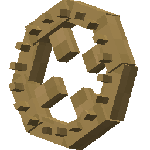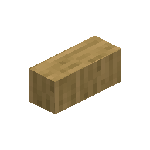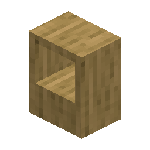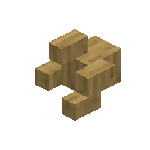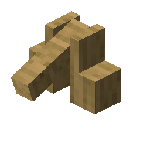| Stackable
|
N/A
|
| Size ↕
|
N/A
|
| Weight ⚖
|
N/A
|
| ItemID
|
terrafirmacraftplus:item.?
|
Parts
Axle
Axles transmit power from a mechanical power source to the device where the power will be used.
Bearing
Axle Bearings support Axles. A single axle bearing can support an axle for up to 7 blocks. Beyond 7 blocks, another axle bearing must be used to extend their range. Axle Bearings are also used to connect Axles to Devices and Gears. Horizontal Axle Bearings must have a solid block or Support Beam below them, while vertical bearings need a solid block or Support Beam on two opposite sides. Sneak to rotate the Bearing when placing.
Gear
Gears allow rotation to be transferred from a vertical Axle to a horizontal Axle, and vice versa, as well as let axles make 90 degree horizontal turns. They also allow the player to change the speed to power ratio of a mechanical system.
Right click the end of an axle which is directly supported by an Axle Bearing to attach a Gear. Shift click a Gear to remove it.
| Wooden Gear
|
Removing Teeth
|
Copying Gears
|
|
|
|
|
Gears are crafted by surrounding an Axle with 4 Lumber and a Saw. The Axle and Saw are not consumed in the crafting recipe. Gears start with 18 teeth. Crafting a Gear with a Saw will return a gear with 1 less tooth. This can be repeated until the gear reaches 9 teeth, which is the smallest Gear. An existing Gear can be copied in one step by adding it into the Gear recipe along with the Saw and Axle.
Axle Couple
The Couple engages its internal Axle when powered by a redstone signal and disengages the Axle when not powered by a redstone signal. This allows the player to control where rotation will be transferred, and can be very useful for preventing a system from overloading.
Crankshaft
The Crankshaft converts rotation into linear motion. Crankshafts can be attached to the back of a Bellows when there is an Axle adjacent to the space behind the Bellows.
Waterwheel

A waterwheel set up to automate a quern
Waterwheels produce power from falling water. The hub of the waterwheel needs to be mounted between two Axles. In order to operate, the edge of the waterwheel, two blocks away from its hub, must be under a block of falling water. The speed of the waterwheel does not matter - instead, the distance that the water falls determines power. The water can fall from any height, but a greater height has diminishing returns - i.e. the taller the waterfall, the less power each block of height the waterfall has will add to the wheel. Multiple waterwheels can be added in series with each other to sum their power. All waterwheels rotate at the same speed regardless of the height of water powering them.
Note: Waterwheels require vertically falling water and cannot be placed on horizontally flowing water or rivers. This will NOT change in the future to include waterwheels in rivers due to difficulties with implementation and as per request of the Developer.
Power and Load
Power is supplied by a Waterwheel, then transmitted by Axles, Couples, Gears, and Crankshafts to be used by Devices (currently: the Quern and Bellows).
Each turning block (Axles, Axle Supports, Axle Couples, Gears) and Device adds load on the system. The system will operate normally as long as power is greater than load. If load becomes greater than power, the system will lock up, and either more power must be supplied or load removed to make the system operate again.
Connecting blocks (Axles, Couples, Crankshafts) add 1 load per block. A Quern adds 5 load. A Bellows adds load depending on the speed its crankshaft is turning. The increase is nonlinear, so doubling the speed more than doubles the load.
Gear Ratio
Gears with ratios other than 1:1 will multiply or divide the load downstream. A Large 18-tooth gear turning a small 9-tooth gear (2:1 ratio) will double the load and rotation speed of all subsequent blocks and devices. A small 9-tooth Gear turning a large 18-tooth Gear (1:2 ratio) will half the load and rotation speed of subsequent blocks and devices.
Usage
Mechanical systems can currently be used to power the Quern and the Bellows.
Quern
Querns can be adapted to grind items automatically by adding a Rind and Millstone.
Bellows
Bellows can be automated by attaching a turning Crankshaft to the back of the Bellows. If gears are used to increase the pumping speed, the Forge can reach higher temperatures than they could if the Bellows were pumped by hand. This is essential for late-game metalworking, such as during the Steel age, where Steel must be melted at Brilliant White to create Black Steel.
History
| Beta |
|---|
| 0.86.0 | Added Waterwheels, Axles, Axle Bearings, Axle Couples, Wooden Gears, Crankshafts, millstones and rinds. |
|---|
